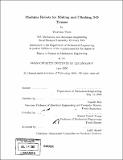Modular robots for making and climbing 3-D trusses
Author(s)
Yoon, Yeoreum
DownloadFull printable version (14.72Mb)
Other Contributors
Massachusetts Institute of Technology. Dept. of Mechanical Engineering.
Advisor
Daniela Rus and Kamal Youcef-Toumi.
Terms of use
Metadata
Show full item recordAbstract
A truss climbing robot has been extensively investigated because of its wide range of promising applications such as construction and inspection of truss structures. It is designed to have degrees of freedom to move in three-dimensional truss structures. Although many degrees of freedom allow the robot to reach various position and orientation, it causes complexity of design and control. In this thesis, the concept of modular robots is suggested as a solution to reconcile a trade-off between the functionality and the simplicity of a truss climbing robot. A single module has fewer degrees of freedom than required to achieve full 3-D motion, but it can move freely in a 2-D plane. For full 3-D motion, multiple modules connect to and cooperate with each other. Thus, modular truss climbing robots can have both properties: functionality and simplicity. A modular truss climbing robot, called Shady3D, is presented as the hardware implementation of this concept. This robot has three motive degrees of freedom, and can form a six-degree-of-freedom structure by connecting to another identical module using a passive bar as a medium. Algorithms to move the robot in a 3-D truss structure have been developed and tested in hardware experiments. (cont.) The cooperation capability of two modules is also demonstrated. As a next step beyond truss climbing robots, the concept of a self-assembling truss robot with active and passive modules is presented. In this system, multiple Shady3D robots are employed as active modules and they become an active truss structure using passive bars. The procedure of self-assembling such a truss is demonstrated in computer simulations, which show a potential application in robotic truss assembly.
Description
Thesis (S.M.)--Massachusetts Institute of Technology, Dept. of Mechanical Engineering, 2006. Includes bibliographical references (p. 139-143).
Date issued
2006Department
Massachusetts Institute of Technology. Department of Mechanical EngineeringPublisher
Massachusetts Institute of Technology
Keywords
Mechanical Engineering.